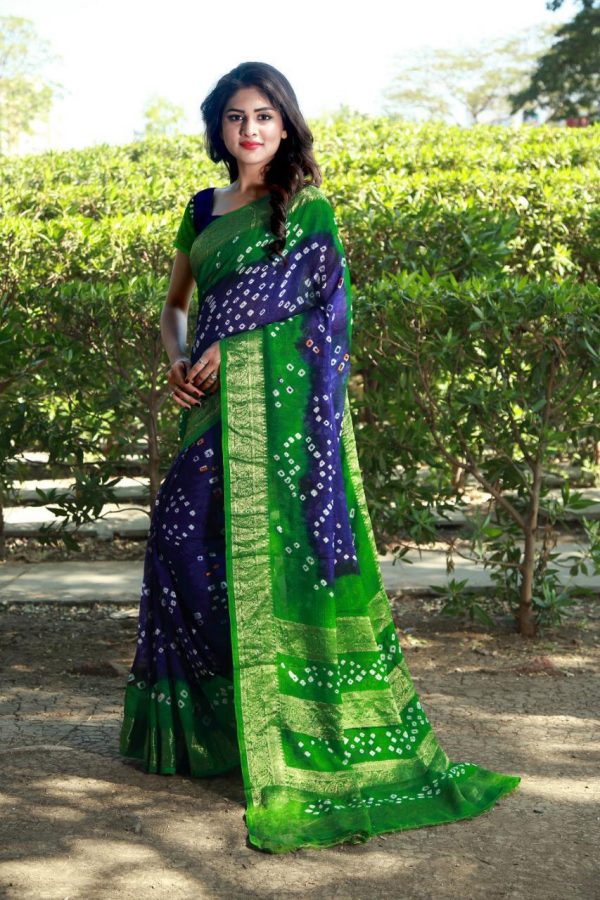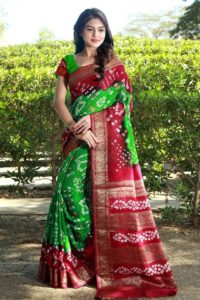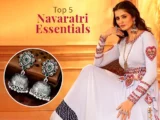
Know More About Bandhani Saree & Their Cultural
Know More About Bandhani Saree & Their Cultural
Bandhani Sarees of Gujarat
In India, the legends in the realm of materials have numerous illuminators and the majority of them have procured this haloed space in view of the many-sided weaves as well as the way in which shading was added to the material. In the event that you ever take a gander at something that helps you to remember the white spots of the smooth way, shining against the scenery of indigo, profound mauve, saffron or charcoal dark, you would realize that those bits are only bandhej-the best close by colored textures, principally made in the conditions of Gujarat and Rajasthan.
What is Bandhani?
The word Bandhani/Bandhni originates from the Hindi/Sanskrit words ‘Bandhan’ and ‘Bandha’, signifying ‘tying’ or ‘to tie’. Bandhej is a variety of this word. Bandhani alludes to the customary Indian ‘tie and color’ craftsmanship (oppose coloring strategy that utilizations impermeable strings for tying), used to deliver wonderful, fine roundabout examples on textures.
How old is the procedure?
Bandhani is old craftsmanship. Most punctual references to this procedure of picking the material with finger-nails and tying, before coloring, are found in Indus Valley Civilization records, going back to 4000 B.C. Indeed, even the Buddhist works of art, going back to the sixth century, in the well known Ajanta Caves have Bandhani references. Writings going back to the hours of Alexander – the extraordinary additionally lauded Indian Bandhani.
Bandhani and other Tie and Dye procedures
Tie and Dye procedure, in different structures, is utilized much of the time in the material plan industry, on textures, shirts, handkerchiefs, scarves, and dresses. In the West, this turned into a fierceness in the late 60s and is related with the Bohemian and Hipster societies. African Tie and Dye strategies are additionally notable.
In southeast Asia, tie and dye color accept the stature of artistic expression. Done by hand, through perplexing, expertise concentrated procedures. In Japan, conventional tie and color are called Shibori (seen on Japanese Kimonos). These expressions utilize perplexing sewing (to make opposition), trailed by coloring.
Bandhan is the Indian form of ‘tie and color’. The examples shaped in Bandhani are way better. Bandhej is the most established type of tie and bites the dust workmanship which started around 5000 years prior.
History
According to the authentic proof, the first Bandhani saree was worn at the hour of Bana Bhatt’s Harshacharita in a regal marriage. One of it’s most punctual visual portrayals can be found in the Ajanta caverns. In India, Bandhani work was begun by the Khatri community of Gujarat. Places in Rajasthan like Jaipur, Sikar, Bhilwara, Udaipur, Bikaner, Ajmer, and Jamnagar in Gujarat are outstanding focuses on creating odhnis, sarees, and turbans in Bandhani. It is an old type of craftsmanship which is still in practice. It commonly works with little roundabout examples – the ‘spots’ or ‘bits’ themes, made utilizing gifted tying – utilizing fingernails, iron-nails and so on. The unmistakable Bandhani dabs are utilized to make different structures, extending from flower to creature designs. In some cases, little squares or different varieties are made as well. Lehariya or leheria is another prevalent Indian tie and color procedure, used to make ‘lehar’ or wave designs. Polished devotedly in Rajasthan, it is utilized to make dynamic turbans, sarees, and dupattas.
Who produces Bandhani?
Bandhani is an Indian hand-done material craftsmanship/make, by and large, completed by talented Bandhani craftsmen, dyers, and laborers just as experienced families included customarily in the art. Numerous ladies and little youngsters in Bandhani focuses tie textures, here and there pre-followed with structures, to make bandhani. These are, at that point, colored, re-tied and re-colored by the men-people of the family. Bandhani is noteworthy materials make the industry, however, it is still little in scale and depends intensely on tedious, conventional procedures and procedures.
The Craft
The craft of Bandhani is as energizing as it’s history. The texture to be colored is tied all-around firmly at various focuses in tangles and after that colored with exceptional hues. At the point when this tied fabric goes for coloring, these strings or bunches don’t give that section a chance to catch shading and enables it to remain white or whatever shading the material has. When the fabric is colored, it is left for drying in outdoors. Drying can take some time contingent on the climate conditions. In a rainstorm, it takes around 2 days to dry while in summer it takes just 4-5 hours. In winter it takes around 6-7 hours for drying.
Style and Variety
Bandhani arrives in an assortment of hues, plans, and designs and these varieties are district explicit. The hues that are most noticeably utilized in Bandhani are yellow, red, green, blue and dark. After the preparing is finished, Bandhani work results into an assortment of images including spots, waves, stripes, and squares. The examples incorporate Leheriya, Mothra, Ekdali and Shikari relying upon the way wherein the fabric has been tied.
The outfits involve Khombi, Patori, Gharchola, and Chandrokhani. Bandhej work can be seen on Sarees, Kurtas, Salwar kameez, and Chaniya cholis. The structures incorporate Ekdali (single bunch), Trikunti (three bunches), Chaubandi (four bunches), Dungar Shahi (mountain design), Boond (a little spot with a dull focus), Kodi (tear formed) and Laddu Jalebi (Indian desserts). Various hues transmit various implications in Bandhani.
Wearing the Attire
Basic Bandhani Salwar Kameez are regular wear for some. Sarees with Leheriya examples are generally worn for day-time functions while Ghatchola lehengas and sarees are worn for events during the evening. Bandhej dupattas with plain white Salwar Kameez are mainstream among little youngsters. Bandhej Sarees can likewise be worn by working ladies for an ideal style articulation, yet keeping it unobtrusive.
Worldwide Appeal
Bandhani is really workmanship and it’s a typical sight to see ladies wearing outfits of Bandhej as well as the men can be discovered wearing turbans with Bandhej themes. The primary market is in Gujarat yet it is being sold all over India as the interest has expanded in the course of recent decades. The business shoots up during the wedding and happy seasons. For the most part, it is utilized as odhnis by the women on celebrations.
Types of Gujarati Bandhej Sarees
The Gharchola maybe would be the best tie and color structure that Gujarat produces.
This fine type of meshing brilliant strings into the texture to be utilized for tie and color is called initially as Gharcholu, however, initially, the texture utilized for that was cotton. Be that as it may, increasingly more of interest for the nearby silk called as gajji has made that a serious staple with the gharcholas.
Gharcholas in Gujarat was utilized before just to make an odhani that was hung on the lady of the hour’s head directly through the function. Its significance is this was the first since forever blessing that the lady of the hour got from her eventual spouse and accordingly was viewed as propitious. Hence, there were endeavors to make it into a saree, and today it is viewed as one of the most significant sarees any love bird has in her trousseau. You can get all these varieties of Gujarati Bandhej sarees at Artisan Glory (both online and retail store).
Maintenance
The quality of Bandhani is lost whenever pressed with a high warmth setting, consequently, it is fitting to get your Bandhej attire dry-cleaned and if necessary be, pressed with a low warmth setting.
Shop Online Bandhej Sarees – www.artisanglory.com







